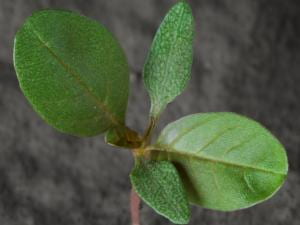By Mark Loux OSU Extension
In our windshield scouting of soybeans this year we have seen a lot of weedfree fields. This makes sense given the shift toward Xtend, LibertyLink, LLGT27, and Enlist soybeans over the past several years, which provides us with effective POST options for our major weed problems – common and giant ragweed, marestail, and waterhemp (now if we could just get rid of the baggage some of these traits carry). We are however getting manyreports of late-season waterhemp as it grows through the soybeans and becomes evident. This also makes sense given that statewide we are in the midst of an overall increase in waterhemp, and continue to move up the curve in terms of number of fields infested and the size of the infestations. Prevention and management of waterhemp and Palmer amaranth has been one of the primary goals of our state and county educational programs for half a decade or more. And one of the most important points about waterhemp and Palmer that we try to get across is their capacity for prodigious seed production – 500,000 to upwards of a million seeds per plant – and what this means for their ability to rapidly ramp up populations, infest equipment, etc.

Flowering Waterhemp
The bottom line here is that it’s essential to scout fields this time of the season and kill or remove plants that could produce seed. Allowing even a few plants to produce seed means an increased population for the next year or two at least. Running harvest equipment through planst loaded with seed is a primary mechanism of spread from field to field. Plants can survive into late season because they emerged after herbicide treatments, or survived an improperly timed and less than effective POST treatment. These plants should produce less seed than plants allowed to grow full season without interruption. It’s also possible given waterhemp’s propensity to become resistant to any herbicide used against it, that the survivors are resistant to whatever POST herbicide was used. Resistance to glyphosate, ALS, and PPO inhibitors is widespread in Ohio, and we expect the development of resistance to dicamba, 2,4-D, and glufosinate will occur given their intensity of use (which is why the current period of clean fields makes us nervous). The only way to ensure that resistance does not develop is to follow herbicide programs with later season scouting and removal of plants to prevent seed. Continue reading Late-Season Waterhemp – The Goal is Stopping Seed →




 survey of OSU Extension County Educators, along with information we had from samples submitted, direct contacts, etc. We still consider any new introductions of Palmer amaranth to be from an external source (brought in from outside Ohio) – hay or feed, infested equipment, CRP/cover/wildlife seedings. Palmer is not really spreading around the state, and as the map shows, we have had a number of introductions that were immediately remediated. The number of counties where an infestation(s) is being managed is still low, and within those counties, the outbreak occurs in only a few fields still. Waterhemp is much more widespread in Ohio and is spreading rapidly within the state from existing infestations to new areas via equipment, water, animals, etc. We do not have Ag Educators in all counties, and even where we do, infestations can occur without us knowing about them. Feel free to contact us with new information to update the maps.
survey of OSU Extension County Educators, along with information we had from samples submitted, direct contacts, etc. We still consider any new introductions of Palmer amaranth to be from an external source (brought in from outside Ohio) – hay or feed, infested equipment, CRP/cover/wildlife seedings. Palmer is not really spreading around the state, and as the map shows, we have had a number of introductions that were immediately remediated. The number of counties where an infestation(s) is being managed is still low, and within those counties, the outbreak occurs in only a few fields still. Waterhemp is much more widespread in Ohio and is spreading rapidly within the state from existing infestations to new areas via equipment, water, animals, etc. We do not have Ag Educators in all counties, and even where we do, infestations can occur without us knowing about them. Feel free to contact us with new information to update the maps. 
